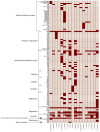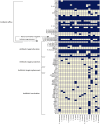A brief insight into Citrobacter species - a growing threat to public health
- PMID: 39816660
- PMCID: PMC11731968
- DOI: 10.3389/frabi.2023.1276982
A brief insight into Citrobacter species - a growing threat to public health
Abstract
Citrobacter spp. are Gram-negative, non-spore forming, rod-shaped, facultative anaerobic bacteria from the Enterobacteriaceae family often found in soil, sewage, sludge, water, food, and the intestinal tracts of animals and humans. Several members of Citrobacter spp. especially C. freundii, C. koseri, C. braakii are frequently detected in newborn illnesses, urinary tract infections, and patients with severe underlying conditions, including hypertension, diabetes, cancer, and respiratory infections, or those who are immunocompromised. Strains of Citrobacter spp. can spread vertically or horizontally from carriers or other hospital sources and thus cause nosocomial infections in hospital settings. A total of 19 Citrobacter genomospecies have been recognized based on genomics. It has been noted that the Citrobacter genus acquired antimicrobial resistance and virulence, including invasion, colonization, biofilm formation, and toxin production. The recent emergence and spread of antimicrobial resistance to β-lactams, carbapenems, fluoroquinolones, aminoglycosides, and colistin in Citrobacter spp. through chromosomal and plasmid-mediated resistance limits the empiric treatment options. Therefore, combination therapy involving costly and potentially hazardous antibiotics poses significant challenges in treating Citrobacter infections. Here we summarized the nomenclature of Citrobacter spp., clinical manifestations, epidemiology, pathogenesis, antibiotic resistance mechanisms, and treatments from various clinical samples. This review will expand our knowledge of the genomics and epidemiology of Citrobacter spp., enabling improved control of infections and the spread of these organisms.
Keywords: Citrobacter spp.; epidemiology; multidrug resistance; pathogenesis; treatment.
Copyright © 2023 Jabeen, Islam, Hassan, Tasnim and Shuvo.
Conflict of interest statement
The authors declare that the research was conducted in the absence of any commercial or financial relationships that could be construed as a potential conflict of interest.
Figures



Similar articles
-
Characterization of a carbapenem-resistant Citrobacter amalonaticus coharbouring bla IMP-4 and qnrs1 genes.J Med Microbiol. 2021 Jun;70(6). doi: 10.1099/jmm.0.001364. J Med Microbiol. 2021. PMID: 34170219
-
An update on the management of urinary tract infections in the era of antimicrobial resistance.Postgrad Med. 2017 Mar;129(2):242-258. doi: 10.1080/00325481.2017.1246055. Epub 2016 Oct 21. Postgrad Med. 2017. PMID: 27712137 Review.
-
Investigation of Citrobacter freundii clinical isolates in a Chinese hospital during 2020-2022 revealed genomic characterization of an extremely drug-resistant C. freundii ST257 clinical strain GMU8049 co-carrying blaNDM-1 and a novel blaCMY variant.Microbiol Spectr. 2024 Nov 5;12(11):e0425423. doi: 10.1128/spectrum.04254-23. Epub 2024 Oct 10. Microbiol Spectr. 2024. PMID: 39387591 Free PMC article.
-
Low-virulence Citrobacter species encode resistance to multiple antimicrobials.Antimicrob Agents Chemother. 2002 Nov;46(11):3555-60. doi: 10.1128/AAC.46.11.3555-3560.2002. Antimicrob Agents Chemother. 2002. PMID: 12384364 Free PMC article.
-
Epidemiology of Citrobacter spp. infections among hospitalized patients: a systematic review and meta-analysis.BMC Infect Dis. 2024 Jul 2;24(1):662. doi: 10.1186/s12879-024-09575-8. BMC Infect Dis. 2024. PMID: 38956542 Free PMC article.
Cited by
-
Genomic characterization of Citrobacter freundii clinical isolates from Tanzania.Microbiol Resour Announc. 2025 Aug 14;14(8):e0036325. doi: 10.1128/mra.00363-25. Epub 2025 Jul 2. Microbiol Resour Announc. 2025. PMID: 40600716 Free PMC article.
-
Characterization of Enterobacter cloacae and Citrobacter freundii Species Complex Isolates with Decreased Susceptibility to Cephalosporins from United States Hospitals and Activity of Aztreonam-Avibactam and Comparator Agents (2019-2023).Antibiotics (Basel). 2025 Apr 5;14(4):382. doi: 10.3390/antibiotics14040382. Antibiotics (Basel). 2025. PMID: 40298548 Free PMC article.
-
[Finger loss during gardening : Necrotizing cellulitis of the index finger].Unfallchirurgie (Heidelb). 2025 May;128(5):383-386. doi: 10.1007/s00113-025-01552-3. Epub 2025 Mar 6. Unfallchirurgie (Heidelb). 2025. PMID: 40050450 German.
-
Draft genome sequences of Citrobacter cronae isolates recovered from food animal production chain in Nigeria.Microbiol Resour Announc. 2025 Aug 14;14(8):e0020125. doi: 10.1128/mra.00201-25. Epub 2025 Jun 27. Microbiol Resour Announc. 2025. PMID: 40576349 Free PMC article.
-
Modulatory Effects of Tetraselmis chuii Gastrointestinal Digests on Human Colonic Microbiota.Foods. 2025 Jun 16;14(12):2106. doi: 10.3390/foods14122106. Foods. 2025. PMID: 40565715 Free PMC article.
References
-
- Abady N. R., Abdul S., Salman K. (2021). Antimicrobial effect of silver nanosilver particles on multi-drug resistant isolates of kluyvera cryocrescens and Citrobacter freundii . Ann. Romanian Soc. Cell Biol. 25, 6687–6701.
-
- Aguirre-Sánchez J. R., Quiñones B., Ortiz-Muñoz J. A., Prieto-Alvarado R., Vega-López I. F., Martínez-Urtaza J., et al. . (2023). Comparative genomic analyses of virulence and antimicrobial resistance in Citrobacter werkmanii, an emerging opportunistic pathogen. Microorganisms 11, 1–17. doi: 10.3390/microorganisms11082114 - DOI - PMC - PubMed
-
- Arana D. M., Ortega A., González-Barberá E., Lara N., Bautista V., Gómez-Ruíz D., et al. . (2017). Carbapenem-resistant Citrobacter spp. isolated in Spain from 2013 to 2015 produced a variety of carbapenemases including VIM-1, OXA-48, KPC-2, NDM-1 and VIM-2. J. Antimicrob. Chemother. 72, 3283–3287. doi: 10.1093/jac/dkx325 - DOI - PubMed
-
- Ashish K., Singh N., Aggarwal A., Khanna M. (2012). The antibiotic resistance pattern in citro-bacter species: an emerging nosocomial pathogen in a tertiary care hospital. J. Clin. Diagn. Res. 6, 642–644.
Publication types
LinkOut - more resources
Full Text Sources
Miscellaneous

